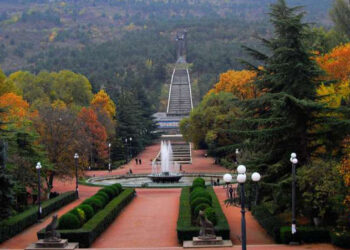Read Part 1.
Generally, the implementation of a major project is not connected only with the purely economic dimension, and security considerations are its natural parallel phenomenon.
In this sense, the Middle Corridor initiative, given the very complex geographical area of the route and the countries along it, will not only be no exception, but will be full of complex and contradictory layers of security. It is also clear that the corridor will divide countries into two large groups: One will benefit from the project, while the other will lose from its implementation.
The security challenge has become particularly urgent against the backdrop of the war in the heart of Europe, as well as developments in the Middle East. Here, we do not specifically address one of the most critical issues of the Middle Corridor – the status of the Caspian Sea. Although significant steps have been taken in recent years regarding its status, some legal aspects are still unclear. In any case, the regime of the Caspian Sea requires a separate qualified consideration, and in this article we only summarize the security challenges of the Middle Corridor.
The specifics of the project lie not only in the narrow transport but also in its energy component. Thus, the relevant infrastructure includes various offshore or onshore installations, connecting facilities and communication arteries. In short, it is a huge geo-economic space that needs careful protection. And in the context of such a large project, some may find it almost impossible to provide absolute protection.
In the section on the competitiveness of the Middle Corridor, we have already mentioned that in this respect it has a different correlation to the Northern and Southern directions. At first glance, even this circumstance largely determines the difference between supporters and opponents of the project.
Despite the obvious forms of aggression in our time and the return of conventional wars between the great powers, we believe that the Middle Corridor project is more threatened by quasi-state actors than by formal state structures. This is with the caveat that the line between “state” and “quasi” has now been erased, and the “state” uses “quasi” to achieve the same public policy goals. One of the best examples of this is the Wagner Group, operating outside Russia, and the Islamic Revolutionary Guard Corps, operating outside Iran. All the more so as this “disguised” form has recently been promoted by official structures, and the trend will increase, both within state financed terrorism and in other latent formats. It is not the task of this article to assess the practical ability of these military units or, if you will, the likelihood of their attacking transport communications. Here, we only want to note that when considering the threats associated with the Middle Corridor, the protection component of the relevant infrastructure should be scrupulously considered. Of course, a number of cross-border projects have accumulated enough knowledge for us. The experience of Baku-Tbilisi-Ceyhan and Baku-Tbilisi-Erzurum are also very valuable.
However, it is also a fact that technology is changing rapidly, and with it the methods of terrorism, diversion, and sabotage, and the methodology of their implementation is very different from the once familiar orthodox “operational culture”. That is why the corresponding countermeasures require a much broader institutional and strategic understanding on the part of the beneficiaries of the Middle Corridor project.
Further Promoting the Middle Corridor
Above, we have mentioned the challenges that need to be addressed in order to launch and successfully operate the Middle Corridor Project. We also mentioned and briefly described the challenge of a separate major category.
It is a fact that the working process in this regard is moving forward, and at this point the status is very encouraging. For example, the signing of a so-called “road map” by the foreign and economic ministers of Georgia, Azerbaijan, Turkey and Kazakhstan was devoted to solving a number of key aspects in the long term. In parallel with highway issues, the mentioned document is aimed at eliminating so-called bottlenecks for transit and improving coordination on streamlining transport infrastructure in the Caspian Sea and Black Sea region.
Along with the specific contributing factors, it is necessary to note the general attitude supporting the project. This background, expressed through direct or indirect actions or statements, is no less important than the issuance of a political and legal act. For example, the Cooperation Council of Turkic-speaking States has assigned a special role to improving the transport potential of the Middle Corridor and its competitiveness. The Kazakhstani authorities’ unequivocal call last July for Kazakhstani companies to seek alternatives to the Russian route is of great importance.
The viability of the Middle Corridor is also strengthened by the agreement between the EU and Azerbaijan to double the supply of natural gas to the European market. Although the above-mentioned deliveries are carried out through separate communications, the Trans-Anatolian and Trans-Adriatic pipelines, their combined effect will again serve to strengthen the Middle Corridor, which runs through the region.
Speaking of the circumstances contributing to the project, the plan to diversify it with digital content is particularly noteworthy. The introduction of new technological innovations aimed at digitalizing the Middle Corridor will take the project to a completely different dimension, giving it long-term competitiveness and high quality commercialization. Equipping the Middle Corridor with digital technologies is the goal of the roadmap, which, as we mentioned, has already been signed, and involves improving technological standards along the Middle Corridor route, implementing appropriate algorithms, and developing infrastructure and operational capabilities.
Recent processes also require a renewed approach on the part of the West. There are many examples of a turn toward the region (e.g., the EU’s two-billion-euro program to deepen transport cooperation in the Eastern Partnership format (together with Azerbaijan)), but such a turn requires more consistent policies and greater investment. Targeted programs to integrate the Black Sea and Caspian Sea markets and unify the rules of the game for cross-border projects would also be highly desirable in the prism of this stage of cooperation.
And another opinion, this time related to a more objective reality: neither China nor Turkey – the two key participants in the Middle Corridor project – should have much desire to depend on Russia in terms of cargo flow. This is largely due to the fact that China is against the strengthening of Russia’s position in Central Asia, while for Turkey, cooperation with Russia is dictated only by a tactical motive, the so-called “marriage for convenience.”
New Content, New Dimension
We mentioned in the article that our region is characterized by developments and changes in a rapid, compressed time frame. Without going too far, it is enough to mention the relatively short period of time between the idea of writing this article and its publication. In that time alone, two such fundamental projects have been announced that will have a direct and lasting impact both on filling the Middle Corridor with new content and on our region’s transition to a new geopolitical and economic dimension.
One of them – the deep-sea port of Anaklia – is a project of Georgian “origin” from beginning to end, the construction and operation of which heralds a high degree of integration of Georgia into the broader economic picture. The credibility of the announced initiative is based on the readiness of the state to participate in the construction of the Anaklia Port. This is the signal of conviction and firm intention not only to its own but also to the international audience, which should dispel any hesitation or doubts.
Obviously, the rest will show in the near future, as the realization of the Anaklia project will have to overcome a number of objective and other possible obstacles.
Another initiative that is now being implemented and which will have a profound effect on processes in the region is the Black Sea underwater power line project. Much has been said about its multidimensional strategic importance. However, given the regional impact of the mentioned project, it is never superfluous to return to this topic and highlight it. We also want to focus on some critical aspects in this article. Some of them have already been mentioned more than once, and others we will formulate with new emphases.
In particular, the Black Sea underwater power transmission line project: (1) will lead to the transition to clean energy; (2) will contribute to the decarbonization of the economy; (3) will be a communication line connecting the two extreme shores of the Black Sea and the Caspian Sea; (4) will create the basis for Georgia to become an electricity hub and integrate the country into the EU electricity market; (5) will encourage new investments in the Georgian energy sector and at the same time support improving the social background; (6) with increased production and supply of electricity, will help our country better position itself in the region not only as a transit connector, but also as a contributor; (7) together with new economic opportunities creates the basis for greater security for Georgia; (8) by activating an additional powerful belt of interconnection and interdependence will create new motivation for stability and prevention of complications in the region.
Practically, participation in the Black Sea underwater power line project helps Georgia update the main identifying mark of its economic and national security – the functional need and practical usefulness of the country. After all, the real function is the main principle of protecting Georgia’s state interests, which we have talked about many times. Thus, after the high-profile projects of the last century (Baku-Supsa, Baku-Tbilisi-Ceyhan, Baku-Tbilisi-Erzurum), the underwater power line and Anaklia projects are indicators of the next order of geopolitically and geoeconomic optimal positioning of the country. Accordingly, after demonstrating the appropriate will, it is now a question of our national willingness and proper fulfillment of specific obligations: to turn these projects (as well as other relevant initiatives) into real, practical benefits.
More than a Project
We believe that through the opinions and assessments presented in this article, we have once again reminded readers of the multilayered and multifaceted purpose of the Middle Corridor project. Almost all along the corridor line, it is planned not only to arrange the infrastructure logistics necessary for transportation and transit, but also to develop a qualitatively different format of coordination between the countries participating in the project, adapted to modern requirements. In a new world in which there is a great lack of predictability and clarity of events, targeted cooperation initiatives can make up for this deficit by playing a kind of compensatory role. Along with other means, we believe that it is precisely such targeted projects that enable the self-sustaining functioning of a major economic hub that has emerged against the background of the trend toward a so-called regional networking (hub-and-spoke), as well as interaction and interconnection with other major hubs.
The connection through the Middle Corridor project is actually a kind of a hub. Its operation, together with various micro-tasks, serves two main purposes: (1) to improve the socio-economic background through the operationalization of the corridor, to create a welfare-enhancing belt, and (2) to attempt a kind of reincarnation of the concept of “Angellism” (according to its author, Norman Angell) in the large geographical space of the corridor, where free trade and greater interdependence between countries should apparently drastically reduce the possibility of wars and conflicts.
This approach to achieving “peace through economics” is as interesting as it is relevant and controversial. And the Middle Corridor project is likely to fall within this broad range. “Running through” projections for years to come would not be a serious undertaking at this point. However, there are already several variables that will affect the implementation of the Middle Corridor project. In order not to engage in the listing of such variables in the overall picture, and specifically with regard to the large Black Sea region, these are: (a) the dynamics of relations between Azerbaijan and Russia; (b) Turkey’s renewed role in the region; (c) the likelihood of a peace agreement between Azerbaijan and Armenia and (d) the prospects for normalization of relations between Turkey and Armenia.
The fact is that the Middle Corridor Project additionally demonstrates that the processes in the geographical area of its coverage have approached a new stage. This is especially noticeable in one of the most dynamic and complex regions of the project – the Black Sea region. Here we can talk not only about a stage, but also about a kind of historical crossroads. It is understandable that we all want events to have a proper development that is acceptable to Georgia’s interests. And this requires both lucky objective factors and our individual intervention. What is undeniable and characteristic of this time is the rapid pace of change, without undue delay. Thus, it is possible that by the end of this year, a number of assumptions mentioned in the article will virtually materialize, and one or another caveat will become a concrete circumstance.
By Victor Kipiani, Chairman of Geocase














